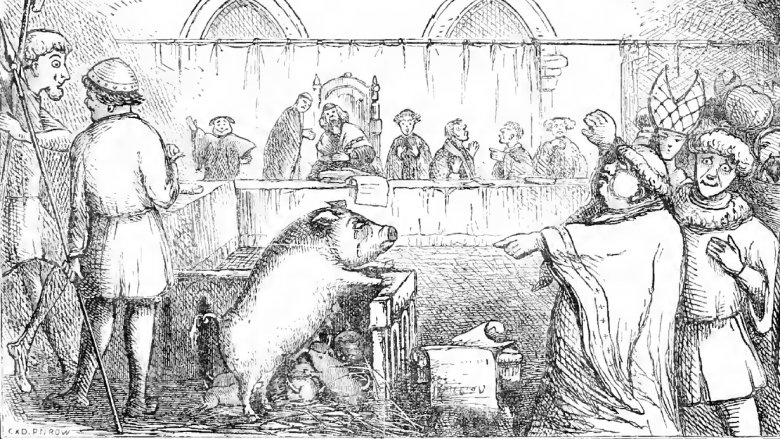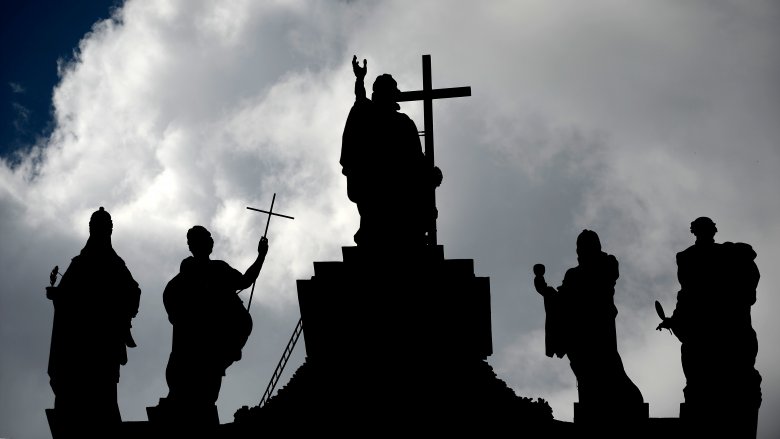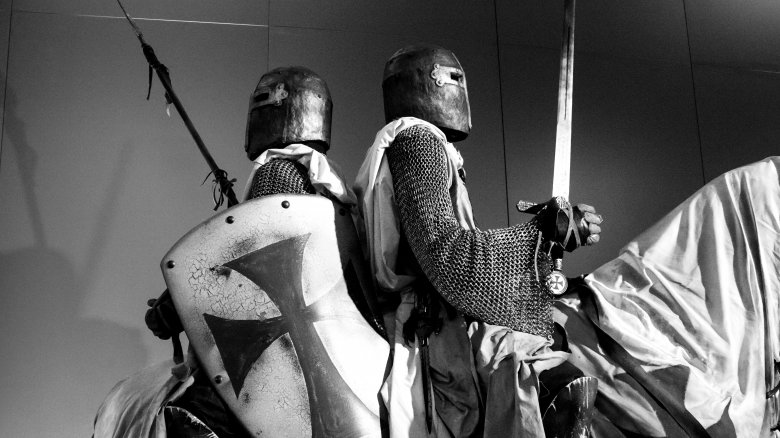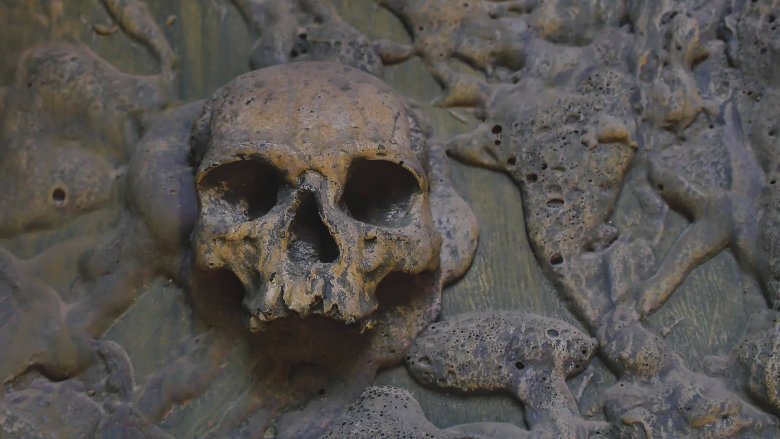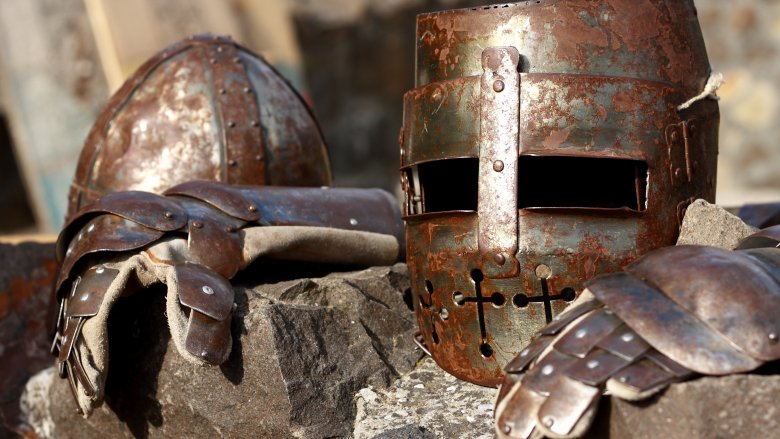Messed Up Things That Actually Happened In The Middle Ages
Not much happened in the Middle Ages, right? Probably some plague, some hunting witches, and not a lot of bathing. There were a lot of peasants, some higher-ups that weren't so covered in mud, and strange women lying around in ponds distributing swords. That last part might not be totally historical, but there were a lot of weird things going on in the centuries of the Middle Ages. They're not all what you think, either.
Animals were put on trial for their 'crimes'
You've seen the headlines, usually atop one-sided accounts of dog racists shouting about how certain breeds are just bad dogs. (Not true. Dogs prefer being good dogs, given the chance.) It turns out persecuting dogs — and other animals — for their actions is a very medieval thing to do, with one major difference. Way back then, they got a trial.
The whole thing was really bizarre. According to Wired, animals were held morally accountable for crimes like assault and even murder starting in 824, and the practice continued into the 1700s. Animals found guilty of their crimes would often be either burned alive or hanged. If that wasn't possible, they'd be ordered to leave town at a certain day and time. Yes, that happened, and it was a big deal. In the 1500s, Bartholomew Chassenee made a name for himself defending hordes of rats, and in 1587 weevils were taken to court for invading St. Julien, France.
The 1906 book The Criminal Prosecution and Capital Punishment of Animals lists around 200 animals who were executed in medieval Europe for various crimes. Pigs were a frequent offender, like the French pigs who killed Perrinot Muet in 1379. (Only three of the herd were executed, perhaps as an example to the others.) Not all animal trials ended in execution, as the courts did occasionally recognize them as victims of violence instead of as perpetrators, but many ended with horrible acts of cruelty.
The Cadaver Synod
In 897, Pope Stephen VI held a bizarre trial at the Basilica San Giovanni Laterano in Rome, and it ushered in what even devout Catholics call the most corrupt era of the papacy. There are a ton of complicated historical maneuverings against the background of this one, but we'll get right to the point. Stephen VI had been pope for less than a year when he ordered his predecessor, Pope Formosus, dug up and placed on trial. Formosus had already been excommunicated, and the trial was pretty much Stephen yelling at a corpse for crimes like wanting to be pope. Atlas Obscura says it's possible he was trying to take attention away from his own crimes, that he wanted to cement some political alliances, or he was just nuts. Smart money's on all three.
Formosus was found guilty, was stripped of his papal finery, had his blessing fingers cut off, and reburied. Stephen then had him dug up yet again and thrown into the Tiber.
Rumors started circulating that his body had washed up and started performing miracles because why not? Mob justice came for Stephen, and according to Christianity Today, the nutty pope was removed from office, installed in a jail cell, and mysteriously strangled not long after. The next pope — Theodore II — overturned the verdict of the Cadaver Synod and outlawed the whole idea of corpse trials, though it shouldn't really need outlawing.
Deggendorf and the anti-Jewish pilgrimages
The widespread hatred of Jews started with the belief everyone who was Jewish shared a bit of the responsibility pie when it came to Christ's crucifixion, and antisemitism was thriving by the Middle Ages. Deggendorf demonstrated that horribly.
The Public Medievalist says the official history told the tale of the good Christian citizens of Deggendorf and the Jews who preyed on them. The story says the evil Jews convinced true believers to steal Holy Communion bread so they, the horrible Jews, could desecrate it. Fortunately, Jesus and the Virgin Mary appeared instead, a miracle happened, and those good Christians returned the bread to its rightful place. The other story — the one historians say is closer to the truth — is that there was a massive harvest failure in 1338, and the story about the bread was made up to justify the town's massacre of its entire Jewish population.
The Deggendorf massacre not only sparked a series of similar killings in surrounding towns, but it was immortalized in the town's church. Relics and paintings paying tribute to the killings became the center of a pilgrimage that attracted good Catholics from all over. It was huge: in 1721 alone, around 40,000 people went on a pilgrimage to Deggendorf. As unthinkable as that is, it gets even worse when you know the pilgrimage was encouraged by the Nazis, and it wasn't until 1992 the church removed all things associated with the pilgrimage celebrating the massacre.
The Children's Crusade
You've heard of the Crusades, a series of holy wars waged by the Catholic Church in an attempt to regain control of the Holy Lands. The Children's Crusade sounds like it should be a war waged by children, and it totally was.
One group was led by a 12-year-old shepherd named Stephen, who claimed Christ had appeared to him and told him to go forth and conquer. Christianity Today says he approached at least one king, Philip of France, asking for support for his mission, but Philip very rationally told him to go home. Undeterred, he started preaching to recruit a band of faithful children and lead them to the Holy Land.
Crazy, right? Who would follow him? Well, thousands of children mustered to the call of both Stephen and another child leader named Nicholas. Word spread, and while it's not clear what happened to the children of the Children's Crusade, The Economist says most of them didn't return home. Some were killed when the ships they'd hired to take them closer to the Holy Land were wrecked, and others boarded ships that took them to Egypt and a life of slavery, instead of to the righteous war they'd planned on. Some even made it to Rome, and while it's thought some of Nicholas' crusade may have made it as far as the Holy Land, history has essentially forgotten their grand designs and devotion.
The condemnation of black cats
Everyone's heard the stories about black cats being associated with witches or the devil, even though any black cat would tell you it's just a smear campaign. They're actually right; Pope Gregory IX kicked off that campaign in 1232.
That's when he wrote Vox in Rama, which was supposedly an expose on the secrets, activities, and rituals of a cult of witches in northern Germany. He's pretty specific, too, even reciting some of the ritual words used when they summon the Devil himself. (A really cynical person might wonder how he knew these secret rituals.) He also says they summon a black cat that appears to be kissed and adored by the worshipers, and because the pope isn't without a sense of humor, he says they all also kiss the cat's "hind parts."
The black cat had also been linked to the rituals of the Cathars and the Waldenses, but The Great Cat says Vox in Rama truly sealed the cat's fate. It was issued by the same pope who sent inquisitors out looking for heretics. Cat hunters were out in full force, too, killing cats with a stomach-turning determination. Owlcation says cat populations dropped to near-extinction levels in some places, but they got their payback when their lessened numbers led to a skyrocketing rat population and, in turn, more plague. That's karma for you.
Mob football
If the term "mob football" sounds like more riot than sport, that's a pretty accurate impression of what medieval football or Shrovetide football actually was. It's the precursor to modern football (both American football and soccer).
Owlcation says the basics of the game were, well, pretty basic. The ball was a leather bladder, and the goals were a random distance apart — anywhere from a few hundred yards to miles. Anyone could join in, there was no limit to players, and ... that was pretty much it. FIFA's history of the game says the idea of "get this ball to this goal and this is fun, seriously" started around the eighth century, and early mob football rules included only two rules: no murder, and no manslaughter. They were different times.
Some of the stories say the whole thing started not with a ball, but with the head of a Danish prince who learned the hard way Britain wasn't about to be conquered easily. No matter, kings spent a good part of the Middle Ages trying to ban it and encourage their good citizens to pick up a useful pastime instead, like archery and learning to kill people in more civilized manner. According to History Channel Australia, Edward II, Edward III, Richard II, and Henry IV all banned football, but it didn't work. People loved their football — bumps, bruises, accidental death, and all.
Cannibalism during war and famine
The thought of eating someone is pretty bad, but it's impossible to say what you'd do to survive without being in that situation, so let's all just take our judging hats off right now.
Now that we're all comfortably non-judgmental, let's talk about all the times medieval people were driven to cannibalism just to survive — these are just documented cases. On December 12, 1098 (via History Channel Australia), Crusaders massacred Muslim soldiers and civilians alike in the city of Ma'aarra. It came at the end of a long siege, and around 20,000 people were killed after being promised mercy. That's horrible. Just as horrible was the cold winter, dwindling supplies, and starvation. Contemporary chroniclers wrote of the Crusaders boiling and grilling the bodies of their conquered foes.
According to The Independent, British and Irish famines in 695, 936, and 1022 all led to cannibalism. Famine struck Egypt in 1201, and human flesh was pickled and jarred ... just in case. Human meat was on the menu in 10th-century China, and according to the Irish History Podcast, medieval people were driven to cannibalism during famines in 1271, 1295, and between 1315 and 1318. As much as 15 percent of Europe's population died during that last famine. You'd think your neighbor looks pretty tasty, too.
Pope Innocent VIII kicks off the season of the witch
It turns out popes are responsible for unleashing a heck of a lot of pain and suffering on the world, and if that's not ironic, nothing is ... except the name of Pope Innocent VIII, who kicked off the season of the witch in 1484 with a papal bull denouncing German witches. According to History Channel Australia, it blamed witches for the Little Ice Age, a period of cold and crop failures that led to mass starvation and crime. It also appointed Heinrich Kramer and Jacob Sprenger as the pope's own witch hunters.
We all know generally what happened then. Witches continued to be linked with weird weather, and according to Scientific American, men and women alike were accused of conjuring storms and making life generally unpleasant. There was a lot of torture, some trials, and some executions.
But here's the really weird thing — it wasn't always like that. Witchcraft gets a mention in most religious texts, but in 910 chronicler Regino of Prumm wrote that the stories of witches causing trouble and flying on their brooms were fantasy at best and delusions at worst. In 1159, church scholar John of Salisbury argued that the belief that people sacrificed children and practiced witchcraft was nothing more than "a mischievous illusion caused by demons." Anyone who believed in witches was simple-minded and faithless, he wrote. Looking at you, Pope Innocent VIII.
Excommunication and tithing
Tithing was essentially a tax demanded by the church and paid by the faithful, and it was super complicated, according to The Economist, so the simple version is you needed to pay the church either in money or in goods and the tithe was a huge piece of the next-to-nothing you actually had.
The church generally got a tenth of what you made, and if you were poor, that meant giving things like seeds, grains, food, or even an offering of animals. According to the history professor Karen Carr, agricultural tithes were collected in huge tithe barns dotted across the landscape, just sitting there and laughing at you.
The penalty for not paying your tithe was excommunication, and that was huge. The U.K. National Archives uncovered a series of documents detailing how, when, and why people were excommunicated. During this time period, common reasons were things like heresy, adultery, or failure to pay tithes, so it definitely did happen. The consequences were very worldly, too. The community was forbidden from associating with anyone who had been excommunicated, and that meant isolation, starvation, and good luck trying to find work, you heathen.
Pope Innocent III's crusade into France
You know crusades as treks into the Holy Land, but in 1209, Pope Innocent III launched a crusade into southern France (via History Extra). He was rooting out a group of heretics in what's now called the Albigensian crusade, and it was a war that lasted 20 years and only ended when an Inquisition was established to finish the work they'd started (via ThoughtCo).
According to University of Kansas medieval history professor Lynn Harry Nelson, the Cathari were a particularly heretical group under the more general umbrella of the Albigensians. While they all believed in the duality of God — a good one versus an evil one — the Cathari preached that the Catholic Church itself was shadier than you think. They believed the same people who crucified Christ had established the Catholic Church and were now playing the worst kind of cosmic joke on everyone by convincing them to worship the very instrument they'd used to kill Christ — the crucifix.
The crusade turned into a full-scale military conflict because the Catholic Church wasn't about to stand for that sort of talk. According to Dr. Stephen Haliczer from Northern Illinois University, when the crusaders took Toulouse, commander Simone de Montfort came up with a horrible solution to a horrible problem. When his officers admitted they didn't know who the heretics were, the response was, "Kill them all. The devil will know his own." Thousands died.
The Expulsion of the Jews
The Jewish community has never had it easy, and in the Middle Ages, a weird thing happened to them. It started after the Norman Conquest of 1066 when, according to researchers at the U.K. National Archives, they were first invited to settle in England. Over the next century, the crown developed a huge relationship with the country's Jewish community. As Jewish merchants became more successful, they paid more tax to the crown. That was great for those two particular groups, but can you guess who it wasn't great for? The rest of the country, which was going farther and farther in debt to already wealthy Jewish merchants.
Unrest grew, and riots started up in the 1230s. People started dying and in June and July 1290, Edward I issued the Edict of Expulsion. By November 1, all of England's Jews had been forcibly removed from the country.
According to historian Arnold S. Leese, there was a laundry list of crimes attributed to Jews in the century leading up to the Edict of Expulsion, including blood libel and ritual murder. He says the last straw was likely the uproar over the murder of a boy in Oxford, and he also says Jews were blamed for these ritual murders into the 1840s. England wasn't opened to Jews again until 1655, but seriously, who would want to go back?

